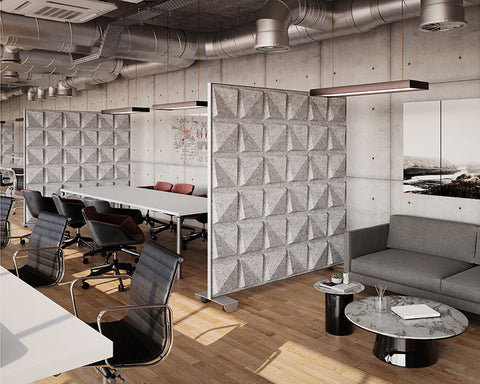In our former Philadelphia studio—a onetime fortune cookie factory—we had the good fortune of asking the right design question: What if you didn’t need walls to divide a space or a room?
At first, it was just a thought experiment. But like most things at MIO, ideas like these have a tendency to turn into products.
Over the years, our design team has turned recycled automotive felt into modular acoustic panels and room dividers, and transformed cardboard and origami principles into our drop ceiling tiles.
What started as a conversation about flexibility became a design manifesto: divide space with elegance, economy, and adaptability.
[products ids="nomad-system-room-dividers, shift-walls-room-dividers"]
Today, "how to stylishly divide your space without building walls" is more than a headline—it’s a design philosophy. One that challenges the assumptions of permanence and offers a more nimble, sustainable, and human-centered approach to architecture.
 |
 |
Why Divide? A Case for Smarter Space Separation
We love openness. It invites collaboration, natural light, and fluidity. But it also invites… distractions.
Think noise, lack of privacy, and visual clutter. That’s why many design-savvy homeowners and businesses are turning to modular partitions, acoustic tiles, and room dividers as flexible, adaptable ways to define space. Below, we will provide an overview of the types and functions of room dividers, aiming to answer questions for those seeking the best DIY room divider ideas for rentals, trade shows, or workspaces. Understanding these flexible solutions is key.
Room dividers can:
-
Create quiet nooks for focus or meditation
-
Define work zones in multipurpose spaces
-
Add privacy in shared offices or open-plan homes
-
Reduce noise and improve acoustics in echoey rooms
Of course, they’re not right for everything.
Spaces that require full acoustic isolation—like therapy rooms, bedrooms, or studios—will still benefit from enclosed architecture or soundproofing. However, for creating dual-purpose spaces with modern dividers, these modular solutions excel.
But for the many moments in life where soft separation is enough, modular design can do the heavy lifting with a light footprint.

Acoustics: What Kind of Quiet Do You Need?
When it comes to sound, context is everything. This brings up important questions like, what are acoustic room dividers and do they really block sound? and can a room divider be soundproof? Here's what you need to know.
-
Absorption: Soft, porous surfaces like our Feltforms tiles and Nomad System Felt reduce echoes by trapping sound energy. Ideal for home offices, studios, and shared workspaces. Can acoustic panels be used as room separators? Absolutely, and they are highly effective for absorption.
-
Attenuation: Partition panels that reduce the volume of sound moving between spaces. Our Shift Walls are a go-to choice here—flexible, mobile, and available with acoustic surfaces or prints. When considering acoustic folding screens vs. modular panels: which is better?, modular panels like our Nomad System offer significant long-term flexibility and acoustic benefits.
-
Diffusion: Geometries that scatter sound to improve clarity. Used more for enhancing acoustic quality than blocking noise.
-
Transmission Control: Where privacy is paramount, full architectural separation or high-mass soundproofing is necessary. For those asking, "soundproof room dividers: what actually works?", true soundproofing typically requires more than just a divider, but our products offer substantial sound attenuation.
The key is choosing the right solution for the kind of quiet you need—and not overbuilding when you don’t have to. This is precisely how to choose a room divider based on sound and space.

Placement Matters: Where and How You Divide a Space
It’s not just what a divider is made of—it’s how, and where, you use it.
Effective placement has a direct impact on both visual clarity and acoustic performance. This is crucial for how to divide your office space for better focus & productivity.
The height and configuration of a divider influence how sound moves through a space—and how people experience it.
-
Need more enclosure or absorption? Add additional rows to your Nomad System to reach your preferred height.
-
Want to keep things open and airy? Use the Nomad Felt or Nomad Sled in a lower profile—or use Noamd’s open assembly configuration to let light pass through.
-
Looking to define distinct zones? Use color as a cue.
-
Select hues that signal focus, flow, or function across your layout.
How much acoustic material you need depends on:
-
The volume and shape of your space
-
The hardness of surrounding surfaces
-
The presence of furnishings and people, which naturally dampen sound
Even a few strategically placed dividers can dramatically shift the soundscape—especially in open, reverberant rooms. This highlights the effectiveness of transforming a room with movable dividers – real examples of which can be seen in various office and educational settings. How schools and classrooms use room dividers for acoustics is a prime example of strategic placement.
Movable dividers, especially those on casters, offer unparalleled flexibility. In open-plan offices, they can quickly carve out temporary meeting areas or quiet zones for focused work, preventing sound waves from traveling across the entire space at occupant height. For instance, the goal is often to block sound waves from traveling at ear level, where most conversations occur. In classrooms, these dividers can separate noisy activity centers from quiet reading corners, or create smaller group instruction areas within a larger room. The height of the divider directly corresponds to the height of the occupants and the size of the space; a taller divider offers more attenuation for standing adults, while a lower one might suit children’s play areas. They are also highly effective at preventing sound waves from hitting hard, reflective surfaces like bare walls, glass, or concrete floors, which are common in modern spaces and cause unwanted echoes and reverberation. Instead, the soft, porous surfaces of acoustic dividers absorb these waves, improving overall sound clarity and comfort. Beyond blocking sound, these dividers can visually signal a shift in function or promote a sense of privacy essential for concentration.

Choosing Your Divider: A Quick Guide
Whether modular, mounted, or mobile, MIO systems are designed to adapt to your environment—and evolve with it.
To help you determine which MIO Culture room divider best suits your needs, consult this quick guide highlighting key attributes across our product lines:

Best Materials for Acoustic Modular Dividers: A Deeper Dive
When considering how to choose a room divider based on sound and space, the materials used are key. While we've highlighted our sustainable options, it's worth understanding the broader landscape of acoustic materials, including some that come with a higher environmental cost.
Less Sustainable Acoustic Materials: Performance vs. Planet Materials like fiberglass panels and various foams (melamine, polyurethane) are common for sound absorption. While effective at trapping sound, their production is energy-intensive, uses non-renewable resources, and disposal is problematic, often leading to long-lasting landfill waste and potential VOC emissions.
Natural & Sustainable Alternatives: Effective, But With Considerations Natural materials like wool are excellent sound absorbers due to their fibrous structure. However, wool can be significantly more costly. At MIO, our commitment to sustainability drives our material choices, prioritizing recycled content like the rPET felt used in our wall tiles and room dividers. This material offers strong acoustic performance with a drastically reduced environmental impact. Our focus on mono-material designs and technical cycle compatibility ensures our products are designed for reuse and reintegration, embracing a circular approach. This allows us to offer effective, beautiful solutions without compromising our environmental values.

Pattern + Color = Personality
Room dividers don’t just organize space—they tell its story.
At MIO, we’ve developed a rich, intentional approach to color that makes our divider systems not only functional, but beautifully coordinated across product families.
Our felt-based room dividers—including the Nomad System Felt, Sled Room Divider, and Shift Walls —all share the same curated felt color palette. This palette includes a range of warm and cool tones that can be mixed or matched to fit any environment, from soft and residential to bold and branded.
Whether you're designing for a home office, a creative studio, a lobby, or a trade show booth, our palette adapts. You can go monochromatic and minimal, or combine hues for something vibrant and expressive—all while maintaining a sense of visual cohesion across your space.
Because this same felt material is also used in our Feltforms acoustic tiles, the color story can extend seamlessly across walls, ceilings, and dividers—allowing for unified acoustic and aesthetic solutions throughout a room or entire building.
The Nomad System in cardboard features a distinct palette of its own, with colors selected to complement a wide range of schemes. The palette is more vibrant as a way to balance out the earthy feel of the cardboard modules, while still fitting comfortably within broader interior palettes.
No matter the configuration, these systems were designed to work together—to divide space with purpose, and color with personality.

Divide Thoughtfully, Live Better
At MIO, sustainability isn’t an afterthought—it’s our origin story, our purpose.
Every product begins with a question: Is this necessary?
If the answer is yes, we make it as resource-conscious and as beautiful as possible. If the answer is no, we move on.
Our divider systems are designed to support not only space and sound—but also circularity.
That means materials chosen for their integrity over time, modular formats that evolve with your needs, and construction methods that simplify reuse and end-of-life recovery. For those wondering where to buy soundproof room dividers in the US that are also sustainably made, MIO Culture is a leading option.
We prioritize:
-
Recycled content, like the rPET felt used in our wall tiles and room dividers
-
Mono-material designs that are easy to disassemble and recycle
-
Technical cycle compatibility, meaning products can be taken back, broken down, and reintegrated into future manufacturing streams
-
Modularity and adaptability, so spaces can be reconfigured without rebuilding—or rebuying
Products like our Nomad System, Shift Walls, and Sled Room Dividers are intentionally flexible.
You can change their layout, swap out components, or repurpose them entirely.
That kind of adaptability doesn’t just reduce waste—it extends the life of the product, and the purpose it serves.
We believe that dividing space should:
-
Support focus and collaboration
-
Be easy to change and easy to love
-
Use low-toxicity, recyclable materials
-
Be made in facilities where people and planet are respected
That’s why our materials are Red List–free. Our products are designed for disassembly. And our supply chain is increasingly regional, so we can make things close to where they’re used.
Because what you divide—and how you divide it—says everything about what you value.
Summary: Key Takeaways for Smart Space Division
-
Flexible Solutions: MIO Culture offers sustainable, modular solutions for how to stylishly divide your space without building walls, promoting adaptability and a human-centered approach.
-
Acoustic Benefits: Our products like Feltforms and Nomad System excel in sound absorption and attenuation, ideal for reducing distractions and enhancing focus in open spaces.
-
Strategic Placement & Movable Dividers: Movable dividers (especially on casters) are crucial for creating flexible zones in offices and classrooms, blocking sound waves at occupant height, preventing reflections off hard surfaces, and fostering privacy and focus.
-
Material Matters: While materials like fiberglass and foam offer acoustic absorption, they carry a significant environmental footprint. MIO prioritizes sustainable, recycled content like rPET felt, emphasizing circularity and responsible manufacturing.
-
Customization & Aesthetics: Our dividers are highly customizable in color and configuration, allowing for unique expression and seamless integration into any design, ensuring both purpose and personality.
-
Sustainable Philosophy: Our core belief is in creating beautiful, durable, and resource-conscious products designed for longevity, reusability, and minimal environmental impact.




